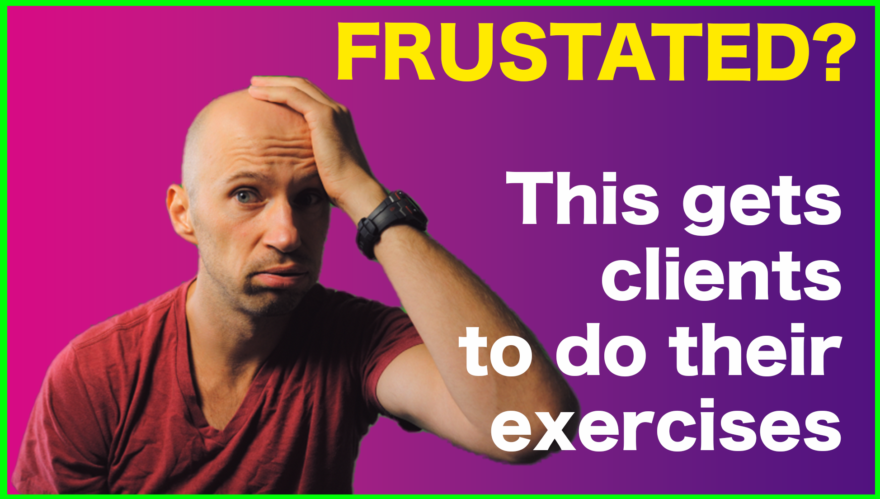Table of Contents
Exercises don’t work if your clients don’t buy in or execute them well
Exercise selection IS NOT the biggest barrier to client success.
What is? The client ACTUALLY carrying out the home exercise program and performing the exercises to your standard.
Sadly, there isn’t a magical breathing technique that can help increase client compliance.
But there is something that does–an effective communication system.
What I’m going to show you in this post and video is the PROVEN system that I use that both enhance client/patient compliance and ensures that their exercise program is carried out savagely well.
If you care about client outcomes, then check out the post and video below to learn more.
Why do the best programs fail?
You’ve designed the best movement and rehabilitation program of all time for your supreme clientele. You explain all the cool biomechanics, teach how breathing in this certain area or feeling this certain part of your body is going to increase their movement capabilities, and you coach the exercise up like you’ve never coached before!
But then you run into a problem.
The client either executes the home program poorly OR neglects to do it at all.
What do you do then?
No breathing exercise can fix poor patient/client compliance.
HOWEVER!
There are some solutions I’ve found useful with my peeps that:
- Increase program adherence
- Improve exercise execution when clients are on their own
This occurs through creating effective systems, which I’ll show you.
Read on!
Increasing exercise compliance during the session
The first thing that I do is I minimize the number of moves or behavior changes needed that the client must execute.
Many patients who come to see me first start with the insurance route. The unfortunate thing with that business model is that it becomes protocol-driven in order to financially stay afloat. These protocols are 6-12 exercises long and take FOREVER to perform. Most people can’t commit to that.
Exercise selection is best done precisely—choosing activities that provide the minimal effective dose needed for maximizing returns (which is what I teach in my seminar, Human Matrix).
My home program ranges from 1-3 moves to be done daily, with training programs of 2-3 times per week if relevant to the client. Behavior changes that are agreed upon by the client could be substituted for those moves.
The fewer changes made to one’s schedule, the more likely the program will be executed. Huge overhauls generally fail.
How do you balance giving just enough to get an effect without underdosing though?
I’M GLAD YOU ASKED!
There are two things I look at to determine this amount:
- Test-retest interventions – If the client does a move and it gets a desired outcome, we know that it’ll likely work longer term
- Ask the client if said activity is something they can reasonably execute
With the second point, I phrase this question in a specific way that increases compliance: “does that seem reasonable?”

I LOVE this phrase because it is very difficult for people to tell you that you are being unreasonable unless you are. Most people struggle with confrontation or difficult conversations. Use this to your advantage.
If someone thinks the program is NOT unreasonable, you subconsciously pressure the individual to carry out what was asked.
If by some chance they do not do the program, I can always come back to saying that and I might just say, “Well, was the amount that I had given you unreasonable?” That can provoke a deeper conversation about what hurdles or rate limiting steps might have been there that prevented them from performing the exercise program at home.
If you feel a little uncomfortable utilizing that persuasive tactic, you can also utilize motivational interviewing. Here, you have the client rate their likelihood of executing the program on a 1-10 scale: 1 being absolutely no confidence, 10 being EXTREME confidence. If they hit a 7or above, chances are they are likely going to be able to execute the program.
But what if they are less than a 7? Then you can ask what needs to be tweaked to get them above a 7. It could be a logistical issue. Perhaps you give someone a ground-based move and they can’t get down on the ground. Either way, having that conversation increases investment from the client, which is ultimately going to help them execute the program to the frequency that you need.
Setting the stage for improving exercise performance
Now that we’ve increased accountability, how do we ensure clients perform exercises the way we want without them screwing it up?
Well, one, condensing the program is going to help you a lot. Now your client has fewer cues and concepts to remember.
But the second thing that I do is I have them coach themselves through the moves.
In person, I’ll take their phone, film them doing exercises while having them talk themselves through the steps. That way, they have another way of thinking about the different cues and tactics that they need to be able to do to perform the exercise well, and the nice thing about this is they are going to put the exercise in terms that they understand. You can even steal the cues they use for themselves an employ them into future moves, enhancing their movement memory.

Remotely, I will do a screen recording and have them talk through the steps similarly.
Building compliance and exercise performance once the client leaves
Sure, it is okay to be like Sting within the session—watching every breath they take and every move they make—but it is a little creepy doing it outside of the clinic.

So, how do we bridge the gap? How do we ensure that our supreme clientele stay accountable and perform the exercises the way we want them to?
Create a system that facilitates these processes. Here’s how I do it.
The first thing that I do is send the client a session summary, whether via email or writing it on my whiteboard.
In this summary, I list all the steps the client needs to go through to reach their goas, what they need to focus on, and what they ought to avoid. An email or picture of this on their phone allows them to review the plan when they leave.
The pieces included in my summary are:
- Session summary – here’s what we achieved today
- Current focus – the movement skill(s) the client needs to master
- The plan and where they are at currently on said plan
- Reinforcement of what they need to do to execute the plan (i.e. frequency of recommendations, importance of carrying out recommendations)
- A list of the next steps
- Continual reinforcement that success requires and open and honest line of communication with me
The last piece is arguably the most critical. People forget, have lives, and don’t remember every single detail of the conversation that you have had. So, you continually must reinforce the behaviors that you want.
The most important behavior I try and reinforce is having an open line of communication. I’ll say: “Hey, I need you to feel comfortable having a conversation with me if things aren’t heading in the right direction, I have no ego in this.” You’ll have to say things like that throughout. Encourage that it is safe to communicate.
To reinforce exercise execution, this debrief will contain the following:
- Name of the move
- Goal of the move
- Video of me performing the move
- The coaching video of themselves performing the move
- Written cues
The last piece in this email involves reinforcing the goals, what they have to do, and to please contact me if they run into any problems. To encourage this behavior, I say the most successful clients talk to me in this manner.
The follow-up emails
The summary is only one piece. How do we know things are going well when the client is unsupervised?
I tried to create systems to circumvent that, here is how I do that.
Step 1: Check in 3-5 days later
The reason why I wait three to five days is because it gives them a little bit of time to figure out the moves on their own. That is going to help increase their learning through trial and error. You don’t want to be a helicopter clinician.
If you wait longer than that, they might develop undesirable movement habits and then you may have to regress the moves, losing precious time in the process.
Step 2: Check in at midpoint before next appointment
This check in is just there to make sure things are heading in the right direction
PRO TIP: Schedule these emails ahead of time
The nice thing about the internet is you can send these in advance, and I do it right after I finish the call. That way I don’t have to remember to check in with my client. I like the app Rightinbox for this, though most email clients possess this feature.
The other nice thing is that if you don’t hear from your client, most email clients will send a reminder to follow-up. Here I just say “bump.”
SAVING TIME TIP
I have this email sequence all templated up if you’d just like to copy mine, save yourself some time for crying out loud. All you must do is click the button below, put your email in, and you’ll get them ASAP.
Sum up
This is the system that I’ve created over the years that has greatly maximized my client outcomes, buy-in, communication, and exercise execution process.
To summarize:
- Poor patient compliance is a major barrier to rehab success
- Keep exercise selection small, and have the client teach themselves
- Involve the client in deciding what gameplan is reasonable
- Send a summary email and follow-up frequently
What type of systems have you utilized to increase client accountability and compliance? Why do not you go ahead and comment below and let us know

